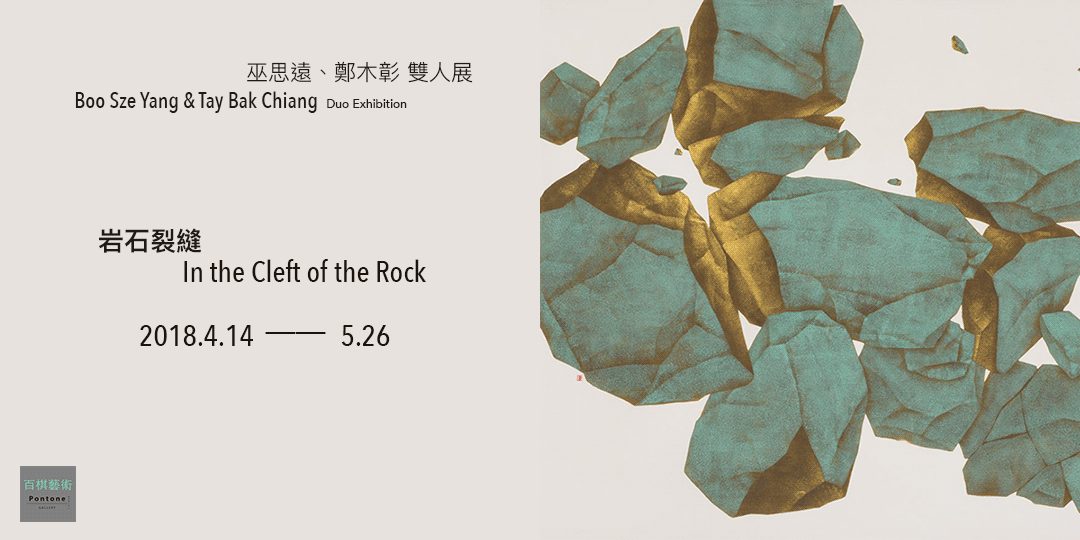top of page

岩石裂縫 In the Cleft of the Rock| 2018.4.14 ~ 5.26
-
藏家預覽:2018.4.14 2-5pm RSVP
-
參展藝術家:巫思遠 Boo Sze Yang、鄭木彰 Tay Bak Chiang
策展人:巫思遠
本次展覽推介兩位來自新加坡的藝術家巫思遠與鄭木彰,以不同的形式、媒材,分別展現他們對於自然環境與地貌的觀察。自然環境與藝術家之間的關係是直接而直覺的,有時甚至遠大過於文化的影響。同樣身為島國子民,現代生活的囧境莫過於來自環境的開發與發展,直接衝擊著大自然的原始生態。此次展出的作品,不但表現出藝術家們企圖捕捉大自然充滿驚喜,令人著迷又變幻莫測的瞬間,更試圖邀請觀者進入當代自然環境持續轉型的另類文人詮釋。
巫思遠近期一系列近乎單色的油畫創作,體現出一個逐漸被城市發展解剖和換置的自然世界。藝術家在畫布表面上然濕漆的原料隨性鋪成,不斷移動濕漆的原料,把過程中留下的痕跡逐漸構建出夢幻般的圖像。畫面處於抽象和具象的邊緣,展現出環境生態在現代建設下產生的矛盾及不可預測性。
鄭木彰的創作題材以石頭為主,以創新的技巧、媒材及顏色,重新詮釋其獨特的形式和巧妙的構圖。透過對於大自然的觀察,藉由畫筆抒發個人情感與當代文人精神。
This exhibition brings together two Singaporean artists who have developed distinctive painting styles in their approach to represent the landscape. The environment where the artists live has a direct impact on their senses, their emotions, their relationships with nature and wider culture. Being a tiny island city-state constantly in a state of construction and renewal, the notion of development and progress has given rise to a long-standing dilemma regarding solutions on modern living and the impact it has on the natural environment. The works in this exhibition attempt to capture nature, not only as they experience it – magnificent, enchanting, unpredictable – but to immerse in its whole and to engage the viewer in a contemporary interpretation of their environment’s ongoing transformation through paintings.
Boo Sze Yang paints imaginative topographical vistas referencing traditional Chinese landscape paintings and Chinese philosophical teachings such as Daoism. His recent series of near-monochromatic visions conjures a natural world gradually dissected and displaced by urban development. This series of painting are constructed via a process of moving, marking and shifting wet paint across a surface, balancing on the edge of recognition and abstraction to create dreamlike images where meaning is constantly shifting and interpretation becomes multifaceted.
For Tay Bak Chiang, nature is perfection, balance and harmony. He believes his work should bear the imprint of his environment and reflect the spirit of contemporary times, even if it is rooted in Chinese ink painting. Hence, he often interprets anew nature themes familiar in Southeast Asia, such as heliconias, banana and palm trees, stones and lotus ponds. Earlier in his practice, he experimented with deconstructing and reconfiguring nature motifs. More recently, he has attempted to move away from representational forms, abandoning motifs that may bear his feelings and points of view. He interprets lotus flowers as minimalist forms; stalks as thick, unembellished strokes; and stones as aloof, silent silhouettes, creating vistas that invite viewers to imagine and discover nature for themselves, just as nature intends for us to do.

1F 鄭木彰作品 Tay Bak Chiang Exhibits

岩石裂縫|新加坡當代藝術
右:鄭木彰Tay Bak Chiang 暗⽯石疑藏虎,盤根似臥龍 Behind the Rock in Darkness A Tiger Probably Hides, The Giant Coiling Root Crouches Like A Dragon 2018 顏料、墨墨與紙 Pigment and Chinese ink on paper 138x138cm 左:李在孝Lee Jaehyo

3F 鄭木彰作品 Tay Bak Chiang Exhibits
右:鳳求凰 Courtship 左:轉⾝身天涯 To the End of the World

2F 巫思遠作品 Boo Sze Yang Exhibits

3F installation view

2F 巫思遠作品 Boo Sze Yang Exhibits

岩石裂縫|新加坡當代藝術

1F installation view from the garden
bottom of page